
Richard Crawley
The Elements of HOTT
Hordes of the Things armies are built up of “elements” each with a small number of figures on a single base of fixed frontage (60mm for 25mm scale figures, 40mm for 15mm or smaller scales). Actually the base size and the number of figures on each base aren’t crucial as long as all have the same frontage. The rules include witty descriptions of what each troop type represents and the strengths and weaknesses of each. Rather than reproduce them here, I’ll try and provide a more Gloranthan context.
Airboats represent slow-moving aerial vessels with some capability against ground troops. Good for blocking some enemy troops’ advance or retreat. Armed Lunar moonboats would certainly be classed as Airboats.
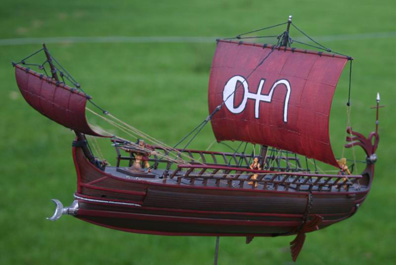
Lunar Moonboat by Gregory Privat
Artillery includes any machines throwing rocks, big arrows or cannonballs at the enemy. Good for seeing off heroes who wander into its line of fire but vulnerable to being overrun in close combat. The Dwarf of Dwarf Run’s Cannon Cult is an obvious Gloranthan Artillery element.
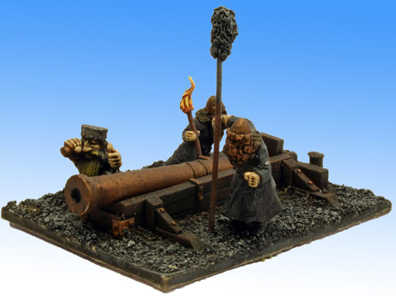
Canon Cult by Gregory Privat
Beasts fast moving troops that are equally at home in good or bad going. They can be useful on the flanks of an army but they tend to die in droves if caught in the open by mounted troops. I tend to classify scorpionmen as Beasts and I think I’d also use the same classification for Telmori (whether two- or four-footed).
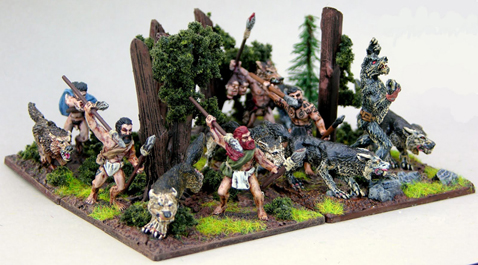
Telmori by Simon Miller
Behemoths includes any oversized elements that rely on their sheer bulk to overwhelm the enemy. Giants, Jolanti, and Quakebeasts are typical Gloranthan behemoths (but a really big Giant might be classified as a God). They tend to flee in panic from magicians and can be very dangerous to (friendly or enemy) troops behind them if forced back in combat.
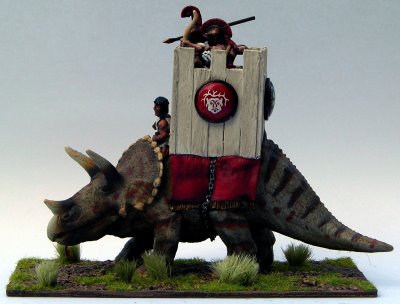
Lunar Behemoth by Simon Miller
Blades represent heavy foot troops, typically with armour and powerful hand-weapons and often skilled fighters. They are slow moving but will stand firm against most foot troops although they are less useful against mounted troops. My Sartarite army includes a Humakti Duck standard guard classified as Blades.

Humakti Blades by Simon Miller
Clerics in HOTT are usually identified with “organised monotheistic religion” but form follows function in HOTT and they can equally well be shamans or theist priests in Glorantha. Their magic is defensive in nature and although they fight reasonably well, their main function is to protect troops from enemy magicians.
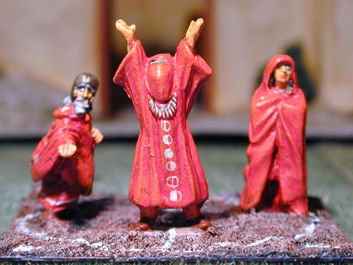
Lunar College of Magic by Simon Miller
Dragons are aloof and ultimately cowardly. Although powerful in combat, they flee the battlefield if things aren’t going their way. A True Dragon is beyond the scope of most games but Dream Dragons would fit in here, as does Simon Miller’s wonderful, massive Crimson Bat model.

Crimson Bat by Simon Miller
Flyers, like all aerial elements in HOTT are hard to co-ordinate with the rest of your army but with their high speed and ability to arrive behind the enemy line at inconvenient times, they can be a battle winner. Jane Williams uses Sylphs and Vanganthi as Flyers to considerable effect in her Sartarite force.
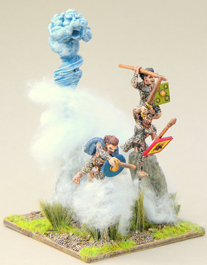
Orlanthi Flyers by Simon Miller
Gods can be lots of fun. The ultimate high reward, high risk element, they arrive if you roll a six at the start of your turn and do nothing else but bring them on. They will then flit around the battlefield causing mayhem and being invulnerable to most enemy troops. The problem comes if you then roll a one at the start of your turn. The God gets bored and wanders off, counting as destroyed! This can lose you the battle. I have Oakfed in my Praxian force as a God. If refighting Moonbroth, Oakfed would be in both sides’ orders of battle with the first to summon him getting to control him.
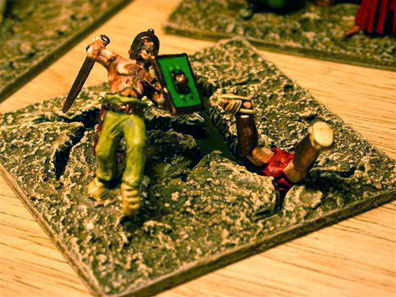
Maran Gor by Simon Miller
Heroes are the classic one-man-with-the-strength-of-an-army. They always count as mounted, even if portrayed as on foot, because heroes in fiction “can always find a mount when they need one”. Hero-Hero or Hero-Paladin fights tend to be short and bloody with one or the other dying heroically. Heroes can be ensorcelled by Magicians. This takes them off the board but leaves the possibility of their escaping and reappearing behind the enemy’s army to kill the General or capture the Stronghold. In my Troll army (representing the Loricek Clan of Pavis) the Zorak Zoran Death Lord is a Hero.
Aerial Heroes fight like Heroes but move like Flyers. They cost an arm and a leg but a couple of these (the maximum you can have) can scare the man rune out of your opponent. Count Julan on a Wyvern might make a very nice Aerial Hero.
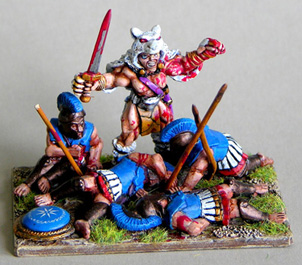
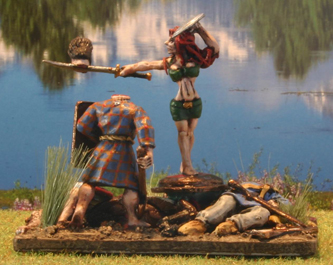
Harrek the Berserk and Jar-eel the Razoress by Simon Miller
Hordes are another fun element type. They represent those troops whose effectiveness is solely due to their being present in huge numbers. A HOTT Horde has a pitiful combat factor but is dirt cheap to recruit. Behemoths treat them like speed bumps. Hordes die in vast numbers but, for a minor cost in the General’s attention, can be brought back again on the army’s baseline. Trollkin are the Horde par excellence (though there is a school of thought that says they should be classified instead as Bad Going).
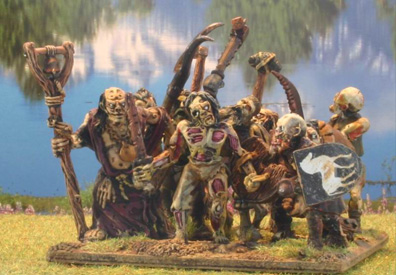
Zombie Horde by Simon Miller
Knights is the category for any mounted troops who rely on impact rather than manoeuvre. They can often plough through foot troops but if they don’t overcome missile troops in the first turn they can come to grief in the second. My emerging Tarsh-Lunar army has Yarandros’s Chargers as Knights but Beast Valley Centaurs or Rhino Riders may also use this description.
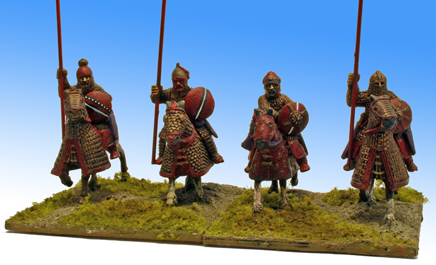
Lunar Knights by Gregory Privat
Lurkers start the game off-board. They can only be deployed on the turn after an enemy element has entered Bad Going and only in combat contact with that element. They represent those lurking creatures that pop up when the author needs to introduce some peril. My Chaos army includes a couple of Jack-o-Bear Lurkers.
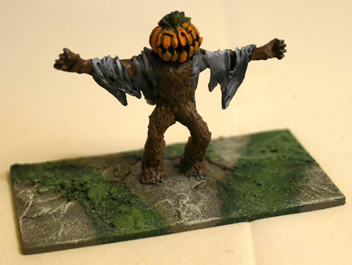
Jack o' Bear Lurker by Richard Crawley
Magicians in HOTT are powerful but not overwhelmingly so. They can “bespell” elements at a distance a bit like precisely-targeted artillery. The details of the spells they use are not explicit – something that helps HOTT to function generically. It’s down to the player to decide what the spell is actually doing to its target. I treat Muriah, Witch Queen of the Broos, as a Magician.
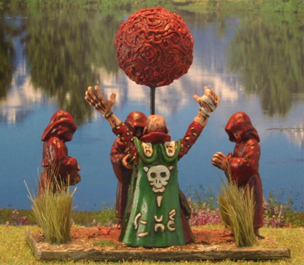
Lunar Magicians by Simon Miller
At first sight the
Paladin with its explicit link to the holy warrior of medieval romance may seem an element with no home in Glorantha. However, because the Standard of Sun County (like a Paladin) never retreats, I have chosen to represent Vega Goldbreath as a Paladin. Paladins, powerful but fragile, share with Clerics the ability to interfere with magic and are often found paired with Heroes to make a scary, fast-moving attack force.
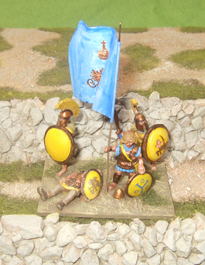
Vega Goldbreath by Richard Crawley
Riders is the key unit type for Praxian armies. Faster than Knights and Beasts but likely to be beaten by the former in combat, they include any troops who skirmish mounted. A useful troop type if the table isn’t dominated by Bad Going, Riders can keep up with Heroes and are often found protecting their flanks. Brian Pierpoint’s Dragonewt army includes swarms of demi-bird-riding ’Newts classed as Riders.
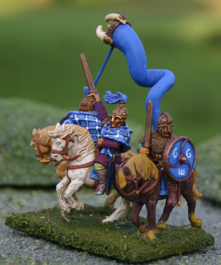
Sartarite Riders by Gregory Privat
Shooters turn the sky dark with their missiles. Many troops have missile weapons but not all are Shooters. Trollkin slings and Esrolian throwing axes are ignored – we treat them part as part of their elements’ close combat factor. Shooters in HOTT can attack units in front of them at a distance. They are generally good for breaking up the enemy’s formation but will occasionally kill an enemy element by shooting too. Good troops to have in bad going, they can be vulnerable if caught in the open by Riders. My Dwarf army includes crossbow and musket armed Shooters.
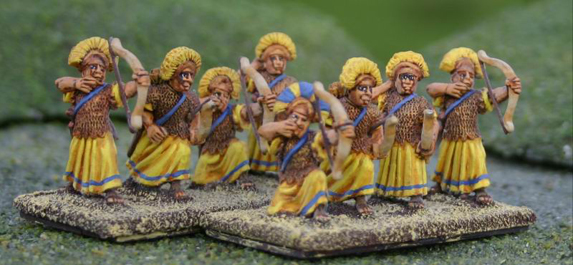
Sun Dome Temple Archers by Gregory privat
Sneakers are that fantasy fiction staple, the small group of seemingly harmless types who gain access to the enemy’s stronghold or take out the enemy general at the crucial moment. They move fairly quickly and are reasonably hard to kill but they are only useful against the enemy’s Stronghold or his General. My Sneakers include a pair of Blue Moon Troll assassins, depicted trailing a Moon Moth towards their target.
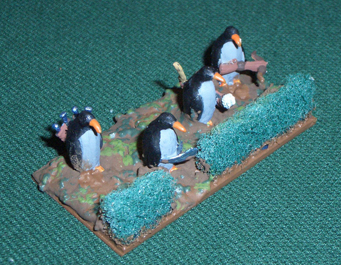
Ninja Penguin Keets by Jane Williams
Spears are quite common in Gloranthan HOTT armies. They form a good, solid centre to an army and are quite strong (especially if deployed “two deep” when they will happily take on Heroes on equal terms) but can be carried away by charging knights or warbands. Gregory Privat’s Sun Dome Templars are classic Gloranthan Spears.
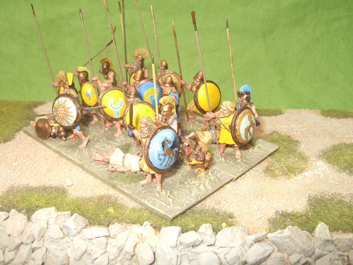
Sun Dome Templars by Richard Crawley
A
Stronghold is present in every HOTT game. The defender’s advantage in choosing the terrain for the game is balanced by the attacker’s (limited) choice of his direction of attack and his ability to win the game by capturing the defender’s Stronghold. Players tend to put a fair amount of effort into designing nice Stronghold models. Jane Williams’s motorised Old Wind Temple was a particularly good example.

Orlanthi Stronghold by Simon Miller
Warband are tribal foot troops relying on a wild, barbarian charge. Fast moving (a widely adopted rules amendment trialled at the first Glory Day speeds up Warbands and slows Shooters) and happy in Bad Going, Warbands can often overwhelm slower moving foot – just don’t let them get caught in the open by Knights or Behemoths. The majority of any Sartarite army will be Warband.
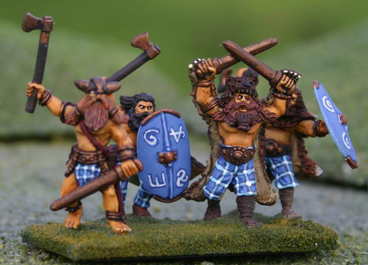
Orlanthi Warband by Gregory Privat
Water Lurkers are among the rarer troops types. The act like “conventional” Lurkers (see above) but can only be deployed in rivers or marshes. Although they cost little to include in your army, you will never get to use one if there’s no water on the battlefield! Apart from the Duck Marsh Patrol mentioned elsewhere in this issue, typical Water Lurkers could include water elementals, sneaky Newtlings or even Mostali submersibles!
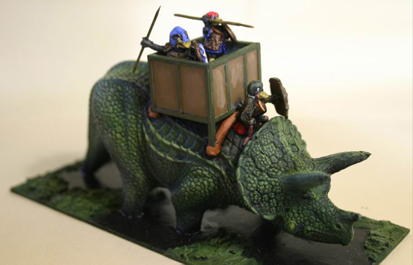
Duck Marsh Patrol by Richard Crawley
Finally, every army has a
General. These can be of most element types (not Dragons, Gods, Sneakers or either type of Lurker) and get bonuses in combat. Losing your General is often fatal, though, but don’t hide them behind a hill either; they need to be able to see what’s going on or your control of the army will break down when things get tough.
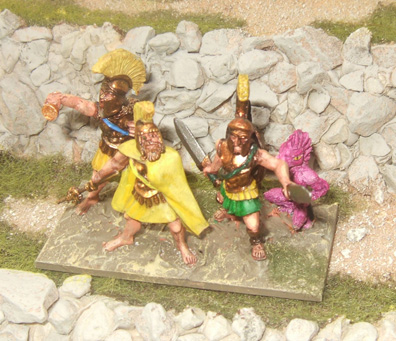
Sun Dome Command by Richard Crawley






























